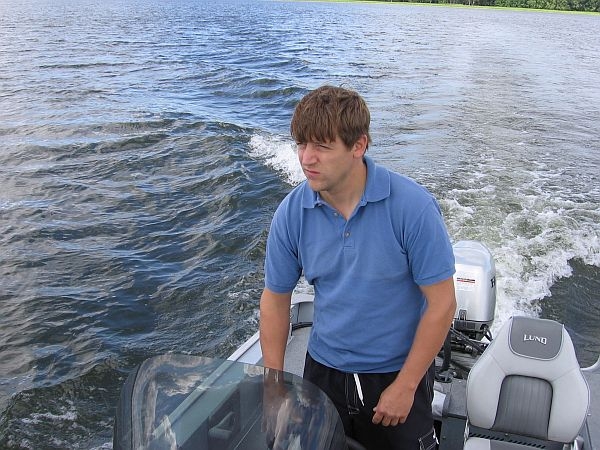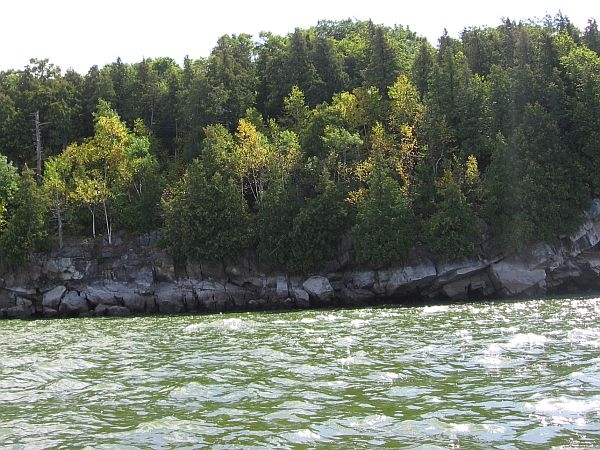 (Host) On Lake Champlain, hot weather and pollution have triggered blooms of toxic blue-green algae.
(Host) On Lake Champlain, hot weather and pollution have triggered blooms of toxic blue-green algae.
The blooms are a near-annual event. But this year, they’ve reached dangerous levels in Missisquoi Bay. The state Health Department say pets and people should stay out of the affected water. And a town in Quebec that uses the bay for its water supply says the water is no longer safe to drink.
VPR’s John Dillon went out on the northern lake to take a look:
(Dillon) The Rock River flows into Missisquoi Bay just south of the Canadian border. It’s the epicenter of this summer’s toxic algae blooms
(Porter) "This is the start of it, this green here on the surface of the water. And you’ll see, it just gets thicker as we get out."
(Dillon) Louis Porter is with the Conservation Law Foundation. His job as the foundation’s "Lakekeeper" comes with a boat, and Porter’s spent a lot of time recently documenting algae blooms on the lake’s northern bays.
(Porter) "On Friday last week the water was flat and it was warm, and consequently the blue green algae scums were covering the surface of water so densely you couldn’t see underneath at all. And where you could, where the boat went through it… it was just dark green, like paint almost."
(Dillon) Recent wind and rain have dispersed the thickest mats of algae. But according to the Health Department, the water is still dangerous. The department has posted its highest alert warning for parts of Missisquoi Bay. Blooms have also been spotted in St. Albans Bay, Pelots Bay on North Hero, and near Alburgh.
The algae release a toxin that irritates the skin and can cause diarrhea and vomiting if swallowed. Dogs have even died from ingesting the stuff.
It’s clear people are trying to avoid the water. Missisquoi Bay is empty. We motor by a summer resort that has big floats and water slides, but no one is swimming. Porter says an unfortunate consequence of the algae blooms is that the public can no longer enjoy some areas of the lake.
(Porter) "I mean this would be just an incredible place to have a house, if it wasn’t for the blue greens right now."
(Dillon) The health concerns led the town of Bedford, Quebec – which draws its water supply from the northern Bay – to warn residents not to use the water for cooking or drinking.
The Vermont Health Department has done extensive monitoring to look for contamination near municipal water plants. The department says no one has been harmed by the algae toxins. State toxicologist Bill Bress says so far the state hasn’t issued any health warnings about town water supplies.
 (Bress) "It would be necessary if we had stagnant sitting blooms around a public water intake continuously. But from what we’ve been looking at the last 10 years that doesn’t seem to be the case and … we still have not had a positive hit inside a public water system."
(Bress) "It would be necessary if we had stagnant sitting blooms around a public water intake continuously. But from what we’ve been looking at the last 10 years that doesn’t seem to be the case and … we still have not had a positive hit inside a public water system."
(Dillon) People may be safe. But as we motor back to the boat launch, we notice hundreds of dead freshwater mussels bobbing in the waves. Most have separated from their shells and the seagulls are having a feast.
(Porter) "Look, there’s a lot of them…dozens of them. Maybe they’re dying… Ugh. That’s a little freaky."
(Dillon) Mike Winslow, the staff scientist for the Lake Champlain Committee, was also unnerved by the mussel die-off. By coincidence, Winslow was also on Missisquoi Bay the same day.
He also saw the lake surface littered with dead mollusks.
 (Winslow) "The two possible explanations I can think of is: one, it may be related to a de-oxygenation event, that they didn’t have enough oxygen at the bottom of the bay, so they died and floated up. The other possibility is that they may be reacting adversely to algae toxins."
(Winslow) "The two possible explanations I can think of is: one, it may be related to a de-oxygenation event, that they didn’t have enough oxygen at the bottom of the bay, so they died and floated up. The other possibility is that they may be reacting adversely to algae toxins."
(Dillon) Winslow says there was a similar event on a Cape Cod freshwater pond last year that was later linked to a blue green algae outbreak.
The mussel mystery is another sign of the lake’s complex, inter-connected ecosystem. The system has been altered by an overload of phosphorus, a nutrient that feeds the algae. The phosphorus comes from sewage plants, farm pollution, and storm water run-off.
Porter and other advocates say the state is not doing enough to limit the amount of phosphorus that flows off the land and into the water.
(Porter) "We haven’t really taken control of even what we’re putting in now, much less what’s already there… The first step toward making a problem better is to stop making it worse. And we haven’t gotten there yet."
(Dillon) Porter gathers up some of the dead mussels. He’s hoping scientists at the University of Vermont can figure out what killed them. For VPR News, I’m John Dillon